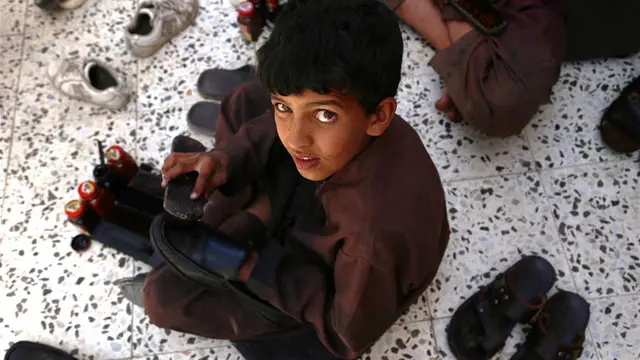
An Afghan child polishes shoes on World Day Against Child Labor in Ghazni province, eastern Afghanistan, June 12, 2017. /Xinhua
Editor's note: Stephen Ndegwa is a Nairobi-based communication expert, lecturer-scholar at the United States International University-Africa, author and international affairs columnist. The article reflects the author's opinions and not necessarily the views of CGTN.
With the escalating social and economic challenges due to the coronavirus pandemic, the destitute status of certain groups or categories of people is bound to become aggravated. One such demographic is children, who even at the best of times suffer serious jeopardy in a world that does not offer sufficient support to vulnerable populations.
In addition to undergoing constant distress from the persistent lack or scarcity of basic necessities, millions of children around the world are forced to work in sweat shops, plantations and mansions in order to support the survival of their families. Consequently, they miss out on education, which in turn enhances the vicious cycle of poverty for generations as their opportunities for a better life than their parents diminish.
These will be some of the issues to be discussed on June 12 as countries mark the annual World Day Against Child Labour. Only that the situation this year is direr as a result of the all-encompassing impact of COVID-19.
Statistics from the International Labor Organization (ILO) - the United Nations agency that advances social and economic justice through setting international labor standards - show that 152 million children aged between five to 17 years old are involved in labor, many of them in dangerous environments.
Out of this figure, ILO says 71 percent of child labor is employed in agriculture, which includes fishing, forestry, livestock herding and aquaculture; 17 percent in services; and 12 percent in the industrial sector, including mining.
Incidentally, these sectors have also been hit hard by the economic shutdowns that were instituted by governments after coronavirus was declared a global pandemic by the World Health Organization in February this year.
In agriculture, for instance, millions of children are out of work due to inactivity on the farms, seas and lakes where their labor was utilized. Additionally, reduced agricultural activity is exacerbating the current food insecurity being experienced on account of COVID-19.

An Afghan child works at a brick factory in Kabul, capital of Afghanistan, June 12, 2019. /Xinhua
The prevalence of child labor also puts into sharp focus the overall adherence to children's rights. For example, the growing illegal use of children for production in various sectors has led to the escalation of child trafficking. According to the U.S. advocacy group
Human Rights First
, children under the age of 18 years comprise about 25 percent, or 5.5 million of the 24.9 million victims trapped in modern day slavery.
Child labor deprives hundreds of millions of children their right to adequate education, health, leisure and basic freedom that are peculiar to children. Worse, still, many of the children in these circumstances are also forced into illicit activities like drug trafficking and prostitution.
The UN Convention on the Rights of the Child addresses four core principles: non-discrimination, devotion to thebest interests of the child and, the right to life, survival and development. With increasing incidents of child abuse globally, the world must seek ways of enforcing the tenets that protect current and future generations.
In the coming days, the world will also mark another solemn occasion, the International Day of the African child, on June 16. On this day in 1976, thousands of black schoolchildren in South Africa's Soweto Township demonstrated against racially motivated inferior education.
Hundreds of children were killed by South African police in the uprising, an event that remains a watershed moment in the struggle against the Apartheid regime in the country. Organized under the auspices of the African Union, the Day of the African Child serves as a stark reminder of the ultimate sacrifice children have paid, and continue to pay, for their freedom and that of their communities. It is also a symbol of the huge challenges sill facing children in the African continent.
For years, African children have suffered widespread violence, particularly as child soldiers during many civil wars in Central and West Africa in the post-independence war decades. Human Rights Watch estimates that about 120,000 boys and girls, some as young as eight years old, had been recruited, either voluntarily or involuntarily, in these internecine wars.
Well, the only excuse for child labor in any form is exploitation and inhumanity. Millions of desperate children are easy prey for those who seek to make profit from cheap labor and slave drivers with no respect for human rights.
The World Day Against Child Labor should serve as a catalyst for current and growing calls to eradicate child labor in line with the global consensus in the ILO Convention No. 182 on the worst forms of labor, and the ILO Convention No. 138 on the minimum employable age. This involves collaboration between all players including governments, both civil society and social groups in a concerted campaign against child exploitation in all its forms.
(If you want to contribute and have specific expertise, please contact us at [email protected])
 简体中文
简体中文

